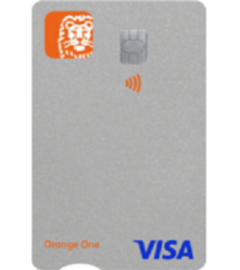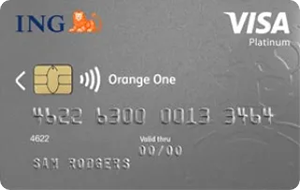ING Credit Cards

ING (the trading name of ING Bank (Australia) Limited) is the world's leading savings bank and is wholly owned by ING Group. They strive to deliver simple, straightforward and great-value products like their ING credit cards for their customers.

ING Orange One Rewards Platinum Credit Card
Platinum credit card with cashback rewards
We found no credit cards using your selected criteria
Update your filters to get more cards to display. Reach out if you are having any problems.
Do you ING?
ING is a financial provider that prides itself on having reinvented the way Australians bank, by delivering simple, straightforward products with great value. Offering simplicity in its approach, ING says it’s this simplicity – and a clear focus on its customers – that has led this award-winning bank towards success.
About ING Direct
With everyday banking and savings accounts, credit cards, home loans, insurance and superannuation products, ING definitely has a lot to offer. In fact, ING has been voted Australia’s most recommended bank. As the icing on top, ING has earned a glittering array of industry awards over the past few years for its customer-focused products.
But, is ING right for you? Since we live and breathe credit cards, we're interested in what they're offering you: what kind of cards, who they work best for, and what to think about before you apply.
ING Credit Cards
Unlike the Big Banks – like Westpac, ANZ, CommBank and NAB – ING doesn’t have a huge range of credit cards to offer. Those big banks tend to have multiple offerings in rewards cards, platinum cards and low rate, low fee cards, which can be a good thing – and it can be a bad thing. Comparing credit cards isn’t always easy, especially when there’s so many options to choose from.
With ING, the choice is more limited. You can either choose the low rate, no annual fee option in the ING Orange One Credit Card, or you can choose the cashback-earning platinum option in the ING Orange One Platinum Card. While you may not feel bowled over by the wide selection, if you look closer, you may just find everything you need in one of these punchy little cards.
Low Rate Cards
What is a low rate credit card exactly? They offer a low interest rate on purchases, and typically, a low rate on cash advances too. The ING Orange One Credit Card fits well within this category of low rate credit cards.
Helping to save cardholders on the interest they pay out, low rate cards can be a great money-saving option. However, it's worth pointing out that low rate cards tend to be low on extravagant features, especially when that low rate is teamed with a low annual fee.
Why is that? Credit card providers need to make money back on their credit cards. If they offer big features and rewards, they need to know they’re not losing money on providing those expensive extras. That’s why you'll usually find big feature platinum cards and rewards cards typically come with a higher rate of interest, a higher annual fee, or both.
However, that’s not to say the ING Orange One Credit Card doesn’t have plenty to offer. One of the most appealing aspects of this card – aside from its low rate of interest and no annual fee – is the feature that allows cardholders to make instalments on large purchases. While you should check the fine print for details, this feature basically allows you to use instalments to pay off large purchases over set terms of your choice, on a lower interest rate.
Why should you choose this type of card?
Is a low rate credit card right for you? Offering the potential to save heaps in interest, a low rate card is the ideal option for anyone who wants a money-saving card. If you tend to carry a balance on your credit card month to month, this type of card could help you save on the interest you pay out. And with that monthly instalment feature, you could save even more.
This type of card could be good if you're new to credit cards. With limited features and a low interest rate, you can get familiar with how credit works before you step into the world of more complicated cards, like rewards cards and platinum cards.
This type of card can also work for anyone who just wants a simple credit card in their wallet. There are no fancy features to pay for that you won’t use, and no rewards programs to get your head around. This is a card that gives you access to credit, with no added frills to pay for.
No Annual Fee Cards
Just as you would expect, a no annual fee card is a card that charges no annual fee. Unlike many other cards on the market that charge an annual fee for their use, this card can be kept in your wallet for free. Well, it will be free as long as you avoid all other applicable fees and pay off your balance before it starts accruing interest. But that’s just a smart way to deal with any type of card.
When we talk about ING's no annual fee cards, we're talking about the ING Orange One Credit Card (we did say their offering was small!). However, as a no annual fee card, the ING Orange One Credit Card is as appealing as a low rate option in its money-saving capabilities.
Similar to low rate cards, low fee and no annual fee cards tend to have fewer features than their more expensive cousins, platinum and rewards cards. But, they do offer access to credit, typically throwing a few handy features into the bargain. The ING Orange One Credit Card, for example, offers mobile payments for ease of use, as well as automatic repayments and notifications to allow cardholders to keep on top of their account.
Why should you choose this type of card?
Most people who opt for a no annual fee card do so to save money. This may be because they actually need to save money, or it may be because they don’t see the point paying annual fees for a credit card when you really don’t have to.
Sure, no annual fee cards tend to be low on fancy features, but if you don’t need those features, there’s no point paying for them. The same goes for rewards programs. With a no annual fee card, you don’t pay for things you don’t need or don’t use.
A no annual fee credit card can also work well for people who want to keep a credit card for emergencies. These are the folks who generally don’t use credit day to day, but who see the advantage of having a credit card in case they happen to need it. A no annual fee card is perfect in these situations, as it typically won't cost money if it's not being used to carry a balance.
Platinum Cards
Platinum cards offer extra perks and features, similar to gold cards and black cards (they also come with a hint of prestige). In the hierarchy of premium cards, black cards are king, followed by platinum and then gold.
Platinum cards can provide any number of perks, from a platinum rewards program to the services of a Platinum Concierge. Other common platinum features include VIP airport lounge access, complimentary insurance cover on travel and purchases, and access to acclaimed travel and retail memberships.
In terms of ING’s cards, the ING Orange One Platinum Card isn’t exactly bursting with platinum features, but it does have a few nifty perks. Similar to the ING Orange One Credit Card, the ING Orange One Platinum Card allows you to pay off large purchases in pre-set instalments at a lower rate of interest.
Another very appealing feature is its ability to earn cashback on purchases. In broad terms, this allows cardholders to earn 1% cashback on eligible purchases made on the card, up to $30 per month. With the potential to earn up to $360 back on purchases each year, this card could provide a great way to save money. Complimentary travel insurance is also up for grabs.
Why should you choose this type of card?
Most people apply for platinum credit cards because they want the extra features on offer. Whether that’s a rewards program or handy extras, those features can offer something extra to cardholders who want to make the most out of their credit card spending.
However, there is a right way and a wrong way to choose a platinum credit card. There’s no point choosing a card for its extras or its rewards if you’re not going to use them, especially when you're paying a premium for them. Instead, you should choose a card that offers features that benefit you, and the spending you do most.
Most importantly, you should choose a card that gives you more value in those features than you pay out in annual fees. It’s also worth noting that if you carry a balance each month, you may pay out more in interest than you get back in features. If that’s the case, a low rate card may be a better option.
What do you need to know about ING?
When it comes to banking, most people like to know a bit about their financial provider. So, what is there to know about ING?
ING is part of the world’s leading bank, and is wholly owned by the ING Group. In its resume, it has over $12 billion paid in savings interest, more than $1 billion invested through Living Super, it has financed more than 475,000 home loans, and has 1.5 million customers and counting.
Their customers seem to be pretty happy with what’s on offer too. ING was declared Australia’s most recommended bank in a 2017 Nielsen poll, when compared by customers of 15 other banks operating in Australia.
Offering simple, straightforward and good value products, ING states it has tackled ATM fees on everyday transactions, while offering simple super solutions for all stages of life, home loans with no ongoing, annual or monthly fees, and savings accounts with no ING fees.
ING is headquartered in Sydney, and has 24/7 Australia-based customer care in Tuggerah. It has held an Australian banking licence since 1999, and like all banks, is regulated by the Australian Prudential Regulation Authority (APRA). This means it offers combined savings balances of up to $250,000 per customer, which are guaranteed by the Australian Government.
Who is eligible for ING credit cards?
To apply for an ING Credit Card:
- You need to either hold an active Orange Everyday, or request to open one along with your Orange One Credit Card
- Be over 18+
- Living in Australia as an Australian citizen or permanent resident
- You earn $36,000 or more per year and have PAYG payslips
ING Credit Cards - Frequently Asked Questions
Recently Asked Questions
Something you need to know? Ask our credit card expert a question.
Ask a question
Hi, I’m a personal finance expert who loves to help you out! I’ll answer your question within a business day. Pinky swear.















Ted Henzen
31 January 2024Pauline
1 February 2024